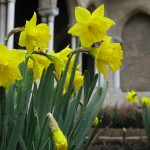Above, from left to right: Rain-drenched daffodils in Bonnefont Cloister garden; a detail from The Hunters Enter the Woods; the later-blooming pheasant???s eye narcissus.
The daffodil now flourishing in Bonnefont Garden is not the wild Lent lily, Narcissus pseudo-narcissus, but a subspecies, N. pseudo-narcissus obvallaris, known as the Tenby daffodil. The parent species, N. pseudonarcissus, the daffodil of the Middle Ages, was not available to us at planting time last fall, but we will obtain stock this year. We had long believed the bulbs that we obtained every year from a Dutch bulb company to be the wild Lent lily. When that particular company ceased to stock the bulbs, we began to look for other sources. I had a conversation with Scott Kunst, a noted expert on historical bulbs, who doubted that what we had been planting had been the true N. pseudonarcissus.
The true Lent lily, he assured me, has a distinctly wildflower-like appearance, and the forward-sweeping petals are lighter in color than the narrow golden trumpet. This daffodil was brought to the United States by early settlers, and can now be found growing in woods and pastures where homes once stood. Scott???s limited stock is??propagated from such colonies.
While we think of the daffodil as a poet???s flower and a harbinger of spring, narcissus species were credited with medicinal powers in the Middle Ages. (See a page from the Index of Medieval Medical Images.) According to the fifteenth-century Hortus Sanitatis, narcissus drew thorns and splinters from the flesh, soothed burns, cleansed wounds, and removed spots from the skin (Anderson, German Herbals through 1500, 1984).
It is often difficult to distinguish between narcissus species in ancient and medieval sources. Furthermore, the name “daffodil” was sometimes confused with “affodil,” the name for an altogether different species, Asphodelus ramosus. Asphodels were a flower of death in Greek and Roman antiquity, and retained that connotation throughout the Middle Ages and the Renaissance. Daffodils, too, as in the poems of the seventeenth-century poet Robert Herrick, have been seen as emblems of mortality, but whether this is attributable to their short life or to a conflation with the asphodel is difficult to say.
???Deirdre Larkin
TO DAFFODILS
FAIR daffodils, we weep to see
You haste away so soon;
As yet the early-rising sun
Has not attain’d his noon.
Stay, stay,
Until the hasting day
Has run
But to the evensong;
And, having prayed together, we
Will go with you along.We have short time to stay, as you,
We have as short a spring;
As quick a growth to meet decay,
As you, or anything.
We die,
As your hours do, and dry
Away,
Like to the summer’s rain;
Or as the pearls of morning’s dew,
Ne’er to be found again.???Robert Herrick
Tags: daffodil, Narcissus, narcissus pseudonarcissus, Narcissus pseudonarcissus ssp. obvallaris, Tenby daffodil




May 4, 2009 at 4:21 pm
great poem! thanks for the medicinal info on daffodils. as always, very informative and useful info. thanks, Deidre!
May 4, 2009 at 4:22 pm
Your blog is a treasure. Whenever I need a quick mental vacation, I come here. Thank you.
May 4, 2009 at 4:23 pm
I am curious why ??? aside from wishing to obtain a more authentic type ??? you plant fresh daffodils each year. They ought to be perennial, and even to spread. Do you dig the bulbs after bloom in order to plant later-bloomers? Or am I mistaken?
May 4, 2009 at 4:23 pm
Ah, I???ve just read backwards to your post on forcing bulbs. Of course you need to buy fresh bulbs in that case.
May 4, 2009 at 4:24 pm
Thanks, Thea???I hope you???ll let me know when you next visit The Cloisters.
May 4, 2009 at 4:24 pm
Thank you, Ann. I hope you???ll visit often.
May 4, 2009 at 4:26 pm
nbmandel???Of course, bulbs can be left in the ground and will multiply greatly over the years, but there is not sufficient room in the small, raised beds of our gardens to allow them to form large colonies over time. Some, but not all, of the bulbs planted for spring display are dug up once they have finished flowering, in order to make room for annuals and biennials, or tender perennial species that are reintroduced after the danger of frost has passed. The spent bulbs are planted in the orchard, or elsewhere on the outside grounds where they can grow undisturbed. Ditto for the forced bulbs, which do eventually recover and contribute to the display. Fresh bulbs are planted in the gardens once the annuals and tender perennials have died back or been removed in October.